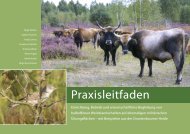TAGUNGSBAND CONFERENCE PROCEEDINGS - Offenlandinfo
TAGUNGSBAND CONFERENCE PROCEEDINGS - Offenlandinfo
TAGUNGSBAND CONFERENCE PROCEEDINGS - Offenlandinfo
Erfolgreiche ePaper selbst erstellen
Machen Sie aus Ihren PDF Publikationen ein blätterbares Flipbook mit unserer einzigartigen Google optimierten e-Paper Software.
Transplantation of a Molinietum<br />
caeruleae meadow in Lower Saxony<br />
(Germany) – a successful case study<br />
Bettina Gehle, Henning Harder, Dietmar Zacharias<br />
University of Applied Sciences Bremen, Faculty 5, ISTAB,<br />
Bremen, Germany<br />
The Molinietum caeruleae meadow recently is considered<br />
as a rare and valuable habitat according to European Habitats<br />
Directive. It contains a high number of endangered<br />
species (e. g. Betonica officinalis, Galium boreale, Selinum<br />
carvifolia, Serratula tinctoria) and is classified as a phytocoenosis<br />
that is very likely to become extinct in Germany.<br />
A Molinietum meadow of approx. 3 ha in the county of<br />
Wolfenbüttel (Lower Saxony, Germany) was separated in<br />
two parts by the construction of the highway A 39 in the<br />
year of 2006. To protect the meadow a compensation measure<br />
was created. About 1 ha of valuable grassland situated<br />
directly within the planned highway lane was transplanted<br />
(sods of approx. 1.5 m² together with 30 cm layer of the<br />
underlying soil) to a nearby former farmland adjacent to<br />
one of the meadow remnants next to the new roadway.<br />
Additionally, on a second target area of former farmland<br />
semi-natural grassland should be restored by transfering of<br />
diaspore-containing hay from the Molinietum meadow.<br />
A monitoring program (all vascular plant species, population<br />
size of endangered species, vegetation of permanent<br />
plots) has been carried out annually since 2005 in order to<br />
document and evaluate the success and the effectiveness<br />
of the compensation measure.<br />
Recently, almost all species of the Red List being typical<br />
for Molinietum meadows and being present in the year<br />
of 2005 before the construction activity started were<br />
found on all reference areas (meadow remnants and the<br />
transplanted meadow). An increase of weed species and<br />
changes in the species composition were observed at the<br />
transplanted site, but the vegetation could be characterized<br />
as the target habitat Molinietum meadow. The numbers of<br />
all individuals of target species were similar to the numbers<br />
counted in 2005. On the second target area with transferred<br />
diaspore-containing hay some target species of Molinietum<br />
could establish and showed increasing populations.<br />
So far the compensation measure can be called a success.<br />
28<br />
Stellwand-Nr.<br />
Poster Panel No.<br />
9<br />
Testing priority effects related to sowing<br />
high and low diversity and time<br />
of arrival of species on assembly and<br />
productivity of grasslands on marginal<br />
land: first experiments in field and<br />
greenhouse<br />
Philipp von Gillhausen 1 , Anita Kirmer 2 , Annett Baasch 2 ,<br />
Vicky M. Temperton 1<br />
1 Plant Plant Interactions and Biodiversity, Institute für Biogeosciences<br />
(IBG-2): Plant Sciences, Jülich, Germany<br />
2 Anhalt University of Applied Science, Department 1, Agriculture,<br />
Ecotrophology and Landscaping, Bernburg, Germany<br />
Main threats to grasslands come from both the intensification<br />
of agriculture and increasing land abandonment.<br />
Land abandonment is a common and increasing across<br />
Europe, and yet, the type of land involved varies, including<br />
both low-nutrient and high-nutrient soils and lowland or<br />
montane sites. Often such land is degraded in some way<br />
through over-grazing, excess nutrient addition, erosion. To<br />
mitigate the loss of these biodiversity hotspots, successful<br />
restoration of degraded marginal land needs to be linked<br />
with sustainable use.<br />
Grassland experiments on old fields and on degraded sites<br />
with sowing of different starting diversities have shown<br />
that initial diversity can significantly drive further assembly<br />
as well as productivity of the community. In addition, there<br />
is evidence from a microcosm experiment that the order<br />
of arrival of different plant functional groups (i.e. legumes,<br />
grasses or forbs) can significantly affect the productivity<br />
and species composition of grasslands over time. We aim<br />
to test whether such priority effects (order of arrival of<br />
different functional groups as well as different sowing diversities)<br />
can improve restoration success and productivity<br />
in grasslands on marginal lands.<br />
As part of a cooperation on Provision of ecosystem seRvices<br />
from grasslands on margInal land across EurOpe: Roles of<br />
plant communIty assembly and functional diversiTY for bioproduction<br />
and restoration success (PRIORITY), we have set<br />
up pilot experiments to test the effects of sowing interval<br />
and seeding density within overall effects of early arrival of<br />
different functional groups on productivity and diversity. In<br />
a field experiment on the Bernburg campus, we are testing<br />
the effect of sowing legumes 2, 4 or 6 weeks earlier than<br />
the remaining forbs and grasses in both high (28 species)<br />
and low (6 species) diversity mixes. In a complementary<br />
experiment in Jülich in large microcosms outside, we are<br />
testing the same species mixtures but also include testing<br />
of sowing grasses and non-leguminous forbs first (as well<br />
as legumes). Finally in a greenhouse experiment we are<br />
testing the interaction effect of sowing at three different<br />
density levels (1.5, 2.5 and 4 g m-2 ) as well as two sowing intervals<br />
(2 and 4 weeks) on the overall priority effects of sowing<br />
different functional groups earlier than others. Initial<br />
results will be presented and implications for overall testing<br />
of priority effects in grasslands across Europe discussed.<br />
Stellwand-Nr.<br />
Poster Panel No.<br />
10




